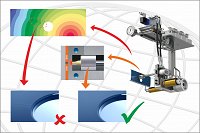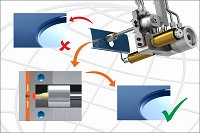Part and process optimization with targeted heat pulses in the cavity
19.11.2021
Direct-Flo™ hot runner systems with Heat-Inject allow for local "heat injections”
Among the innovations that INCOE presented at Fakuma this year, the new "Heat-Inject" product stood out in that it uses the hot runner system as a carrier platform, but instead of melt, it brings heat into the cavity. The question following this concept "But why additional heat directly into the cavity?" is answered by Christian Striegel, Head of Development and Technical General Manager at INCOE International Europe: "This is not an additional heater, but a movable tempering stamp, whose heated tip introduces a heat pulse there by briefly pressing against the rear wall of the cavity." This short local impulse can contribute in many ways to optimizing the quality of the molded part and the process, he says: weld lines and flow lines are still there, but no longer visibly appear on the surface, matt points no longer appear in the area of the gate, areas with low wall thickness the cavity, such as in film hinges or thin-wall injection molding, can be flowed through more easily, and delicate geometries and microstructures are easier to manufacture. "This innovative temperature control technology, based on the patent-pending Z-system from our partner Hotset, works extremely quickly with very low energy consumption. In doing so, it offers a technically relatively simple and robust solution for molded parts with visually demanding surfaces, such as panels for household appliances, consumer electronics, or instrument panels in vehicles," adds Frank Daniel, Commercial General Manager at INCOE International Europe.
The idea of assembling "Heat-Inject" on hot runner systems has its origins in the concept of pre-assembled modules. The idea here is to offer customers components for their injection molds that are already assembled into ready-to-use and ready-to-plug-in modules, thus saving effort and time during tuning and installation. "Of course, the tempering stamp still has to be inked and adjusted in the mold to ensure optimum heat transfer," explains general manager Frank Daniel. "But the fact that all Heat-Inject connections are combined on the central connection plate of the hot runner system, for example, eliminates the need for time-consuming installing and connecting of individual cables or hoses in the mold - everything is already mounted in a module and can be inserted in the sense of "plug and produce" after all adjustment actions have taken place." An essential part of using Heat-Inject, continues Frank Daniel, is clarifying in advance whether and how Heat-Inject can be used. INCOE offers a multi-stage process for this, consisting of a feasibility study, a quotation, and support with coordination, installation and sampling. "A big advantage for us with this new product is that we can build on Hotset's many years of experience and thus offer our customers additional benefits that have already proven themselves in practice." Christian Striegel adds.
 The mode of action of Heat-Inject shown by an example: A heat pulse at the confluence of two melt flows behind a hole makes the weld line invisible.
The mode of action of Heat-Inject shown by an example: A heat pulse at the confluence of two melt flows behind a hole makes the weld line invisible.
 Where otherwise a weld line may become visible due to molding geometry and gating, the heat pulse from Heat-Inject ensures good surface quality.
Where otherwise a weld line may become visible due to molding geometry and gating, the heat pulse from Heat-Inject ensures good surface quality.
 "Plug and Produce" or "Unplug and Service": The hot runner system as a carrier platform for innovative temperature control technology to optimize molding and process quality for products with demanding surfaces.
"Plug and Produce" or "Unplug and Service": The hot runner system as a carrier platform for innovative temperature control technology to optimize molding and process quality for products with demanding surfaces.
INCOE: INjection COntrol Engineering
For more information, please visit www.incoe.com




































